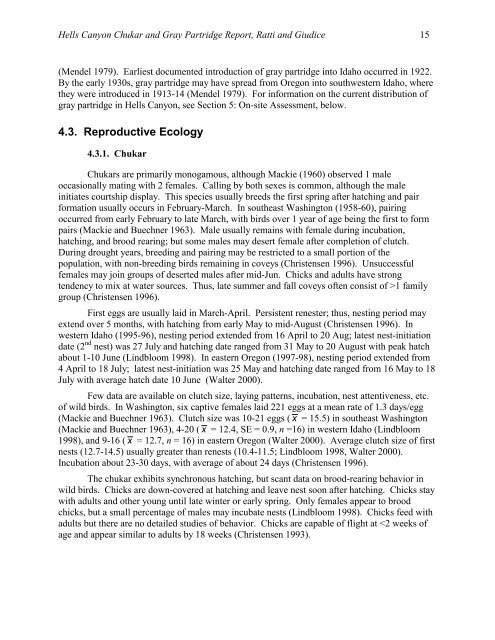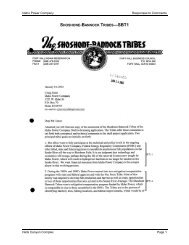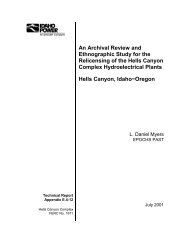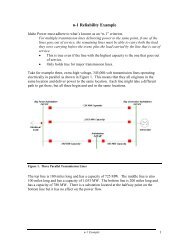Assessment of Chukar and Gray Partridge Populations - Idaho Power
Assessment of Chukar and Gray Partridge Populations - Idaho Power
Assessment of Chukar and Gray Partridge Populations - Idaho Power
- No tags were found...
You also want an ePaper? Increase the reach of your titles
YUMPU automatically turns print PDFs into web optimized ePapers that Google loves.
Hells Canyon <strong>Chukar</strong> <strong>and</strong> <strong>Gray</strong> <strong>Partridge</strong> Report, Ratti <strong>and</strong> Giudice 15(Mendel 1979). Earliest documented introduction <strong>of</strong> gray partridge into <strong>Idaho</strong> occurred in 1922.By the early 1930s, gray partridge may have spread from Oregon into southwestern <strong>Idaho</strong>, wherethey were introduced in 1913-14 (Mendel 1979). For information on the current distribution <strong>of</strong>gray partridge in Hells Canyon, see Section 5: On-site <strong>Assessment</strong>, below.4.3. Reproductive Ecology4.3.1. <strong>Chukar</strong><strong>Chukar</strong>s are primarily monogamous, although Mackie (1960) observed 1 maleoccasionally mating with 2 females. Calling by both sexes is common, although the maleinitiates courtship display. This species usually breeds the first spring after hatching <strong>and</strong> pairformation usually occurs in February-March. In southeast Washington (1958-60), pairingoccurred from early February to late March, with birds over 1 year <strong>of</strong> age being the first to formpairs (Mackie <strong>and</strong> Buechner 1963). Male usually remains with female during incubation,hatching, <strong>and</strong> brood rearing; but some males may desert female after completion <strong>of</strong> clutch.During drought years, breeding <strong>and</strong> pairing may be restricted to a small portion <strong>of</strong> thepopulation, with non-breeding birds remaining in coveys (Christensen 1996). Unsuccessfulfemales may join groups <strong>of</strong> deserted males after mid-Jun. Chicks <strong>and</strong> adults have strongtendency to mix at water sources. Thus, late summer <strong>and</strong> fall coveys <strong>of</strong>ten consist <strong>of</strong> >1 familygroup (Christensen 1996).First eggs are usually laid in March-April. Persistent renester; thus, nesting period mayextend over 5 months, with hatching from early May to mid-August (Christensen 1996). Inwestern <strong>Idaho</strong> (1995-96), nesting period extended from 16 April to 20 Aug; latest nest-initiationdate (2 nd nest) was 27 July <strong>and</strong> hatching date ranged from 31 May to 20 August with peak hatchabout 1-10 June (Lindbloom 1998). In eastern Oregon (1997-98), nesting period extended from4 April to 18 July; latest nest-initiation was 25 May <strong>and</strong> hatching date ranged from 16 May to 18July with average hatch date 10 June (Walter 2000).Few data are available on clutch size, laying patterns, incubation, nest attentiveness, etc.<strong>of</strong> wild birds. In Washington, six captive females laid 221 eggs at a mean rate <strong>of</strong> 1.3 days/egg(Mackie <strong>and</strong> Buechner 1963). Clutch size was 10-21 eggs ( x = 15.5) in southeast Washington(Mackie <strong>and</strong> Buechner 1963), 4-20 ( x = 12.4, SE = 0.9, n =16) in western <strong>Idaho</strong> (Lindbloom1998), <strong>and</strong> 9-16 ( x = 12.7, n = 16) in eastern Oregon (Walter 2000). Average clutch size <strong>of</strong> firstnests (12.7-14.5) usually greater than renests (10.4-11.5; Lindbloom 1998, Walter 2000).Incubation about 23-30 days, with average <strong>of</strong> about 24 days (Christensen 1996).The chukar exhibits synchronous hatching, but scant data on brood-rearing behavior inwild birds. Chicks are down-covered at hatching <strong>and</strong> leave nest soon after hatching. Chicks staywith adults <strong>and</strong> other young until late winter or early spring. Only females appear to broodchicks, but a small percentage <strong>of</strong> males may incubate nests (Lindbloom 1998). Chicks feed withadults but there are no detailed studies <strong>of</strong> behavior. Chicks are capable <strong>of</strong> flight at
















